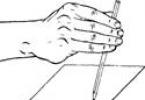When getting into a taxi, you need to remember that there are different rules of conduct if you are in the role of a passenger and not a driver.
1. The driver knows how to drive - he learned it. Therefore, you should not make comments or instructions while driving.
2. It should not be surprising that the driver is wearing a seat belt. Better to do the same.
3. Sitting on front seat, you may accidentally push the gear shift lever with your left knee. You can take this calmly, but almost all drivers are annoyed by it. It's better to move your leg away.
4. When sitting behind the driver or in the middle, you need to be careful not to push with your knees or grab the backs of the front seats with your hands. Especially with requests to move due to cramped conditions. In general, we should be glad that the car is four-seater and not two-seater.
5. There is no need to press the radio buttons with your fingers, even clean ones. And with confidence that this particular button will turn on another song. It's better to ask the driver about this.
6. It’s also better not to press unfamiliar buttons for the purpose of reconnaissance.
7. When boarding, you should ask how hard to close the door, and not slam it hard.
8. If you lure a driver into a traffic jam during rush hour, there is no need to complain that he will be late.
9. If there is a fear that it will blow, then you need to dress warmly in advance.
10. Fidgeting in the seat and saying that the covers have slipped is illogical.
11. If you are allowed to eat and drink in the car, then the trash can is on the street, not under the seat. You should also not throw garbage out of the window.
12. If you can’t open or close something, then it’s not necessary to break it. The driver will do everything himself upon request.
13. You should not grab the car with your hands and leave marks on dusty doors.
14. Do not get your feet dirty on the step between the rear mats.
15. Smoking is not allowed inside the car, and you cannot drink alcohol. There may also be stains on the upholstery of someone else's car.
16. Passengers should not look out of windows or stick out their arms.
17. Disembarkation should be done on the side of the road or sidewalk after the car has completely stopped.
18. If there are children on the road, they should not distract the driver with loud conversations, questions, or games.
19. Bottles of fizzy drinks should be opened when stopping.
20. It is not recommended to use different perfumes with a strong smell, nail polish or hair polish while driving.
21. Do not carry sharp, cutting objects with you, and do not use flammable ones.
22. When getting into a car, you must first sit down on the seat and then move your feet into the passenger compartment. You should exit in the opposite direction. You should not enter the car head first.
23. Sit on backseat taxi is good manners. This will make it clear to the driver that they will not interfere with conversation.
24. If you speak, do not raise your tone, do not swear, and do not bring up difficult topics. It is necessary to have light conversations that do not distract the driver from the road.
25. It is not customary to get into a business class car in shorts and a T-shirt. Or vice versa, a formal suit is inappropriate for the interior of an SUV.
26. A man must help a woman get her luggage.
There are many safety requirements for traveling in a car that are not specified in the rules and are solely the moral responsibility of the driver and each passenger. Most safety measures are included in the rules traffic, and non-compliance is punishable by considerable fines, as we talked about not so long ago. But some features of the current rules safe trip remain a mystery for novice drivers, because they are not discussed in driving school.

Safety rules in a car for every road user, including passengers, are of great importance. For example, during a long journey of one of the tasks front passenger is to maintain contact with the driver in order to determine the moment of danger of the trip, when there is a risk that the driver will fall asleep. In this case, you need to stop for a few minutes and sleep.
The most important rules for a safe trip for the driver
In driving school, everyone was taught that they need to look at the signs and guide their speed solely according to these signs. If it is said that you can drive at a speed of 90 kilometers per hour, you must definitely pick up this speed, but driving at a slower pace is simply unacceptable. In fact, you are free to choose the pace of movement that is comfortable for you. The only exception is the minimum speed limit, which is extremely rare on our roads.

Therefore, when choosing a speed limit, you need to take into account the quality of the road surface, the width of the road, the ability to maneuver and the speed of traffic. If you are driving along the highway in a large convoy of cars, overtaking one after another will be too dangerous and difficult, and it will not give much effect, it will only increase fuel consumption three times. Therefore, you need to adhere to the following unspoken rules:
- it is necessary to move at the speed of the flow so as not to create obstacles;
- driving too slow or too fast will cause poor safety;
- you should always evaluate the situation on the road, as well as the capabilities of your car;
- You definitely need to think about the comfort and safety of passengers when choosing a driving style;
- should be considered weather when choosing a travel speed mode;
- always remember installed tires, and possible problems auto.

The more information you use when choosing travel modes, the less you will want to drive recklessly and show high aerobatics. It is much better to drive confidently and safely than to drive spectacularly, but not for long. Remember that you are not only responsible for your life. The health, as well as the lives of your passengers and other road users, depends on your actions.
We often forget that we are not only responsible for ourselves. In all accidents there are two sides - the guilty and the victim. The representative of the second party could comply with all the rules, public and unspoken, three times, but still ended up in unpleasant situation and became involved in the incident. This brings up another important point. unspoken rule safety - be careful and monitor the actions of other motorists.
Rules for safe travel of passengers in transport
Whether we are talking about cars or trains and buses, the rules for safe travel of passengers will always be the same. It is advisable to keep it in sight traffic situation so that sudden braking does not cause unpleasant consequences. You should also sit comfortably in your seat and fasten your seat belts. The driver is responsible for keeping your seat belts fastened, but only you are responsible for your life.
The passenger must comply with the rules safe movement, regardless of whether the driver of a car or bus agrees to violate traffic rules. If you sit as the seventh person in a car that can really only carry five people, then there can be no question of any safety. In case of any accident in such a car, there will be a very unfavorable situation not only for the health, but also for the life of each passenger. Therefore, the following rules should be observed:
- do not board a vehicle that is already carrying a maximum or excessive number of passengers;
- ride only in a place specially designed for this purpose - in the passenger seat;
- If possible, use safety equipment in the form of belts;
- do not distract the driver, do not shout or try to get out of the car while it is moving;
- sit quietly, do not jump on the seat or rock the car;
- follow the driver's instructions when asked to move or otherwise sit down;
- think independently about your safety, refuse rash actions.

You and only you can ensure the safety of your movement in the car. Never panic, do not allow fear to take over you in any situation. This will only make the situation worse. It is important to understand that it is you who are responsible for a calm environment and a simple resolution of any situation. Of course, the driver's responsibility is great, but you can positively influence it without distracting him from his duties.
If you don’t like the situation in the car or bus, other passengers behave incorrectly, or the driver performs strange actions, ask them to stop the vehicle and leave it. Of course, this cannot be done in every situation, but this way you can save your life. Listen to your intuition and don't let fear ruin every transport trip you make. We invite you to watch a wonderful social video about seat belts:
Let's sum it up
It is important to understand that each person is initially responsible for his own safety, because he himself chooses whether to get into a certain type of transport or not. Each step is our own choice, so it is worth making this choice correctly. The driver is responsible not only for himself, but also for other people. Therefore, recklessness and unreasonable actions while driving are disrespect for yourself and others.
Be careful and always put safety first in your priorities. If certain speed mode seems too active to you, stop and think about how you need to drive to fully feel safe. Have there ever been times in your driving experience when you had to sacrifice safety for speed?
A vast field of activity opens up here, since approximately every third child who became a victim of a traffic accident was a passenger in a car. This proves how important it is to follow these rules:
- Absolutely everyone needs to wear a seat belt! Including in someone else’s car, and when driving short distances. If this rule is automatically followed by adults, then it will easily become a permanent habit for the child.
- If possible, children should occupy the most safe places in a car: middle or right side rear seat, since it is safe to step directly onto the sidewalk.
- As a driver or passenger, you also constantly set an example to follow. Do not be aggressive towards other road users, do not rain down curses on them. Instead, explain specifically what their mistake is. Use various situations To explain the rules of the road, calmly admit your own mistakes.
- During long trips stop often. Children need to move. Therefore, they will try to free themselves from the belts or wear out all your nerves.
Resort to alternative ways transportation: bus, Railway, cycling or walking.
Good afternoon, dear reader.
This article will talk about traffic rules that are intended for passengers Vehicle. IN in this case it's like personal cars, and about public transport.
"Passenger" - a person, other than the driver, who is in the vehicle (on it), as well as a person who enters the vehicle (gets on it) or exits the vehicle (gets off it).
So, a passenger is a road user who is in a car or other vehicle or enters or exits it.
Attention! Please note that a pedestrian becomes a passenger not when he is completely immersed in the car, but at the moment when he decides to do this and begins to move towards the door of the car or bus.
Passenger Responsibilities
Discussed in section 5 of the traffic rules. In principle, there are few responsibilities, but not every passenger is familiar with them.
So, the passenger must be buckled up seat belt , if the car is equipped with such belts. When riding a motorcycle, the passenger must wear a fastened motorcycle helmet. Violation of any of these rules can lead to very unpleasant consequences even in a minor accident.
I emphasize once again that the direct responsibility of the passenger is to wear a seat belt, and this applies not only to the driver, but also to the unfastened passenger.
Prohibitions for passengers
In addition, several prohibitions are introduced for passengers:
1. Passenger should not distract the driver from driving a car. Not every passenger knows and understands this point of the rules. I can’t remember a single passenger who sat calmly and silently the entire way. As a rule, passengers consider it their duty to distract the driver from the road in every possible way.
I note that if the actions of a passenger distract the driver and cause a traffic accident, then it is unlikely that the passenger will bear any responsibility, because It is unlikely that it will be possible to prove his involvement in the accident.
Naturally, we are not talking about a situation where a passenger grabbed the steering wheel and, through his actions, provoked a road accident.
2. Passenger It is forbidden to open doors vehicle while driving.
3. When traveling in the back truck passengers it is forbidden to stand, as well as sitting on the sides or above the sides.
Rules for boarding and disembarking passengers
Traffic regulations for passengers also provide for special rules for boarding and disembarking passengers from vehicles.

Boarding and disembarking must be carried out from the sidewalk or side of the road. Let me note that this is not necessarily about right side roadway. If the road is permitted on the left side, passengers must board the vehicle on the left side only.
Getting into the back seat of a car is almost always possible from the sidewalk. However, the same cannot be said for the front passenger seat. If boarding from the curb is not possible, the rules allow enter the car from the side of the roadway, but must not create interference for pedestrians, bicycles, cars and other road users.
I note that boarding and disembarking passengers falls within the competence of only the passengers themselves, i.e. According to the rules, the driver is not responsible for boarding and disembarking.
However, the truck driver must check with passengers before driving briefing according to the rules of boarding, disembarking and placement in the body:
22.4. Before the trip, the driver of the truck must instruct passengers on the procedure for boarding, disembarking and placing in the back.
For passenger cars and public transport There are no such rules, so compliance traffic rules requirements remains only on the conscience of the passenger himself.
It should be emphasized that until the moment the passenger begins to enter the vehicle, he is a pedestrian. The same applies to the situation when the passenger has already exited the vehicle. In this case, a person must follow the rules for pedestrians:
Fines for passengers in 2019
Code of administrative offenses provides 2 options for fines for passengers:
- Article 12.29, part 1 - warning or 500 rubles. Imposed for any violation of the rules that did not interfere with other road users. For example, such a fine threatens a passenger who does not wear a seat belt.
- Article 12.30 part 1 - 1,000 rubles. Imposed if the passenger interferes with the movement of vehicles. For example, he was not convinced that there were no cars and opened the car door from the side of the roadway.
This concludes the review of the rules for passengers.
Good luck on the roads!
A safe car is a car, design features which help prevent accidents or, in the event of a traffic accident, reduce injuries to the driver, passengers and pedestrians.
An experienced driver will cope with any emergency situation. There are cases when much of the incident does not depend on the driver, since the cause of the accident is either other people or technical faults in general.
You don’t have to fasten the seat belt – it’s all the same at low speed. In an accident at any speed, wearing a seat belt increases the chances of survival by 2-3 times.
Airbags will always save me. Airbags are only effective when belt fastened safety and only at speeds up to 80 km/h, which is even an understatement on the highways.
Airbags are harmless. There are cases where people involved in accidents were suffocated by an airbag. Also, approximately 30% of people lose their hearing when an airbag deploys due to the loud bang that ruptures the eardrums in their ears. There are also cases when they did not work, or worked late. They are installed on modern cars only because the alternatives are even worse.
The safety steering wheel will protect you no worse than the airbags. Products made from safety plastic are designed to reduce impact force, but full protection it doesn't provide. The statistics are sad - safety plastic saved only 3% of lives.
Rear passengers may not wear seat belts in any case. If rear passengers were not fastened at the time of the accident, they can move to any place in the cabin. This is dangerous both for them and for those sitting in front.
Children can ride just like adults. To transport a child, the car must have Baby chair, which ensures protection of the child’s spine and correct fixation with the seat belt.
Hitting from behind is harmless. According to statistics, upon impact standing car more than 50% of cases end in the back fatal. This is due to the fact that the main overloads in this case fall on the fragile and weakly protected human spine.
A side impact is extremely dangerous. In the majority modern cars Side bolsters and side airbags are used, which make this impact the least dangerous. In addition, such impacts usually occur at low speed.
Hitting a truck is always fatal. Many trucks are equipped with underrun bars that prevent a passenger car from getting under their wheels, and bumpers made of soft materials that seriously reduce the force of impact. But a collision with a truck is always much more dangerous than a collision between two cars.
There may be various things in the cabin - what will happen to them. In the event of an accident, objects lying in the cabin acquire the speed at which the car was previously moving. And their mass in this case will be equal to the normal mass multiplied by the speed in meters per second. So the heavier the object, the more potentially dangerous it is.
The trailer will not affect the impact force in any way. This is, of course, not true. A trailer attached to a vehicle can cause significant damage due to its weight and the additional impact from the rear.
Tuning a car does not affect its safety. Of course it does. The lightweight body is less resistant to impacts, and the modified body kit does not have the same energy-absorbing characteristics.
Window tinting reduces vehicle safety. On the contrary: glass with high-quality films absorbs solar glare, eliminates the mirror effect, and neutralizes the glare of oncoming and passing cars. High-quality tinting reflects 99% of ultraviolet rays, thereby protecting the interior from fading. In summer, it reflects up to 70% of heat rays, and even if you have air conditioning in your car, you will not experience discomfort from a very unpleasant effect: your right hand freezes, your left hand burns from the sun. And in winter, the polymer retains up to 35% of the heat in the cabin, keeping it in the car comfortable temperature. And also, no one will see that you forgot something valuable in the car when leaving, going home or to the store. And no one will know in advance what equipment is installed in your car, what speakers and how they are attached.
A tangential blow is not dangerous at all. A tangential impact does not lead to the destruction of the car, but is dangerous due to loss of control over the car and subsequent repeated accident.
A heavy vehicle is extremely dangerous in an accident. On practice heavy car turns out to be more durable and better able to bear loads, since it is able to absorb more load than a lightweight car.



